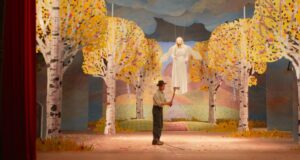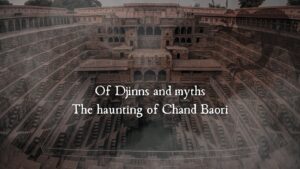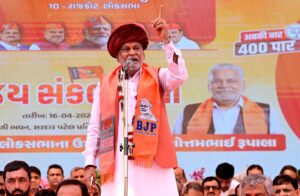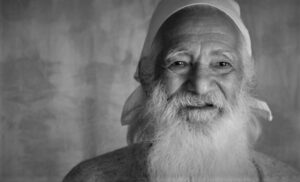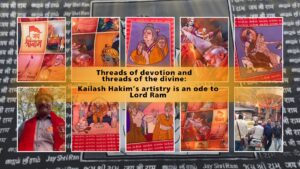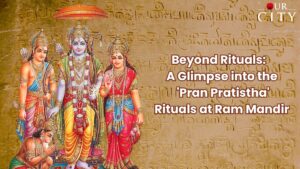Hinduism places a specific emphasis on animals, and some species, such as the cow, snake, elephant, etc., are even worshipped. Ancient tales and the Vedas both describe them. These animals were utilised as ‘Vahan’ (Sanskrit for ‘vehicle’) by gods and goddesses. These mortals are revered in Hinduism for their dedication and skill, and they were typically deployed in times of conflict.
Learning from the Fauna
Animals, like humans, possess a wide range of skills. In several trips, Indian yogis and rishis found the skills that animals possessed. From them, they learned various asanas and pranayama, and through them, they learned diverse yogic gunas. Studying daily life a little bit will reveal that the gods and goddesses only created the animals and birds as their vehicles because they have abilities that they deemed worthy of acceptance.
The braveness of a lion, calmness and patience of elephant, the purity of a swan, the wise brain of rat, the farsightedness and night waking capacity of an owl, these talents have been praised by the gods and goddesses, and they have accepted that animal as their vehicle.
The Reciprocity
The vahana’s good features frequently serve as an embodiment of God, while its bad features are traits that the God force has subdued. They have a reciprocal connection with the god they serve as well as the vahana.
The energies of the gods and goddesses are what we need to awaken inside on the path to self-realization. We must acknowledge who we are not in order to tame it and understand who we are. The tamed ‘Ego’, known as the Vahana, serves to fulfil the realised ‘Divine’ force. The god or goddess may be seen standing, seated, riding, or even sitting next to the vahana. These vahana reflect the many energies (animal energies) that exist in the cosmos and in us, and they must be appropriately channelled and controlled in order for humans to undergo spiritual transformation.
Legends on Vahanas of Gods
Goddess Durga’s Tiger (Dawon)
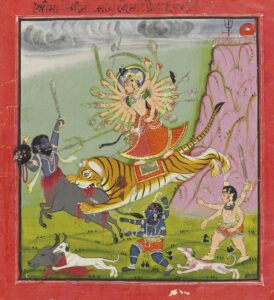 Durga is adored as a mother and the slayer of the wicked. She is said to have developed a black complexion when she spent years performing penance in order to get Lord Shiva. She made the decision to perform penance once more till she turned fair when Lord Shiva made her dark skin, light. And when Mother Parvati (another manifestation of the goddess Durga) was engrossed in penance, a lion arrived to devour her but decided to sit down after seeing her concentration. In order to ensure that the lion received his share of the penance’s reward, the goddess Durga made him the passenger while she performed her penance.
Durga is adored as a mother and the slayer of the wicked. She is said to have developed a black complexion when she spent years performing penance in order to get Lord Shiva. She made the decision to perform penance once more till she turned fair when Lord Shiva made her dark skin, light. And when Mother Parvati (another manifestation of the goddess Durga) was engrossed in penance, a lion arrived to devour her but decided to sit down after seeing her concentration. In order to ensure that the lion received his share of the penance’s reward, the goddess Durga made him the passenger while she performed her penance.
Goddess Saraswati’s Swan (Hamsa)
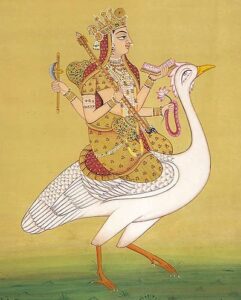 Saraswati is revered as the goddess of knowledge and wisdom, and a swan is said to be her mount. The swan is revered as the most upright bird in Hinduism. You might be wondering why Mother Saraswati chose the swan as her mode of transportation. Because the swan is so clever, it can distinguish milk from water when milk and water are combined. It represents separating right from wrong, accepting what is good, and letting go of what is wrong. And thus the goddess of wisdom, chose the swan to serve as her conveyance.
Saraswati is revered as the goddess of knowledge and wisdom, and a swan is said to be her mount. The swan is revered as the most upright bird in Hinduism. You might be wondering why Mother Saraswati chose the swan as her mode of transportation. Because the swan is so clever, it can distinguish milk from water when milk and water are combined. It represents separating right from wrong, accepting what is good, and letting go of what is wrong. And thus the goddess of wisdom, chose the swan to serve as her conveyance.
Lord Shiva’s Bull (Nandi)
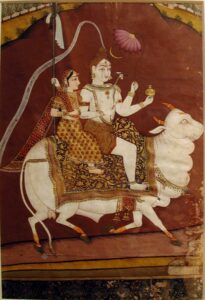 Lord Shiva is revered as the deity of destruction. His mount is a bull named Nandi. Nandi was the son of Shilad Rishi, according to the Hindu Puranas. Lord Shiva had granted a blessing after being pleased with the rishi’s penance. However, Nandi began the penance of Lord Shiva when Shilad Rishi and Nandi learned that Nandi was fleeting. He sought for this blessing, that Lord Shiva should always keep Nandi in his company. Nandi became Lord Shiva’s most beloved student after receiving the gift of a long life and the visage of a bull. And ever since, Lord Shankar has had the honour of using Nandi as his vahan.
Lord Shiva is revered as the deity of destruction. His mount is a bull named Nandi. Nandi was the son of Shilad Rishi, according to the Hindu Puranas. Lord Shiva had granted a blessing after being pleased with the rishi’s penance. However, Nandi began the penance of Lord Shiva when Shilad Rishi and Nandi learned that Nandi was fleeting. He sought for this blessing, that Lord Shiva should always keep Nandi in his company. Nandi became Lord Shiva’s most beloved student after receiving the gift of a long life and the visage of a bull. And ever since, Lord Shankar has had the honour of using Nandi as his vahan.
Lord Vishnu’s Eagle (Garuda)
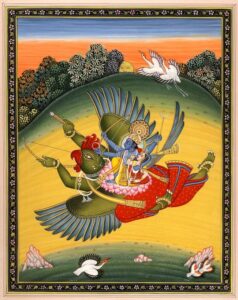 Lord Vishnu is revered as the world’s sustainer. Shesh Nag (a snake) is the resident of Ksheer Sagar (the sea), and Garuda (an eagle) is his vahan. He makes use of their abilities to exterminate the evil, defend human life, and inspire faith among the populace. Vinita, the daughter of King Daksha, and sage Kashyapa had two sons: Arun, who became the vehicle of the Sun deity, and Garuda, who became the vehicle of Lord Vishnu.
Lord Vishnu is revered as the world’s sustainer. Shesh Nag (a snake) is the resident of Ksheer Sagar (the sea), and Garuda (an eagle) is his vahan. He makes use of their abilities to exterminate the evil, defend human life, and inspire faith among the populace. Vinita, the daughter of King Daksha, and sage Kashyapa had two sons: Arun, who became the vehicle of the Sun deity, and Garuda, who became the vehicle of Lord Vishnu.
Lord Ganesha’s Mouse (Mooshak)
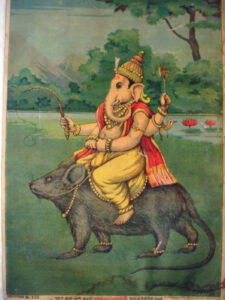 Lord Ganesha is known as the ‘destroyer of difficulties.’ No auspicious task is said to be feasible without Lord Ganesha devotion. The mouse serves as both Lord Ganesha’s chariot and one of his beautiful forms. The gods were once much harassed by a demon by the name of Gajmukhasura, so Lord Ganesha went to battle with him on their behalf. However, he was assaulted by the Gajamukhasura, who broke one of his teeth. This infuriated Lord Ganesha, who then smote him with a shattered tooth, causing the demon to flee in terror like a mouse. The demon began pleading with the Lord for his life. Lord Ganesha, who he prayed to on a regular basis, pardoned him.
Lord Ganesha is known as the ‘destroyer of difficulties.’ No auspicious task is said to be feasible without Lord Ganesha devotion. The mouse serves as both Lord Ganesha’s chariot and one of his beautiful forms. The gods were once much harassed by a demon by the name of Gajmukhasura, so Lord Ganesha went to battle with him on their behalf. However, he was assaulted by the Gajamukhasura, who broke one of his teeth. This infuriated Lord Ganesha, who then smote him with a shattered tooth, causing the demon to flee in terror like a mouse. The demon began pleading with the Lord for his life. Lord Ganesha, who he prayed to on a regular basis, pardoned him.
Lord Kaal Bhairav’s Dog (Shvan)
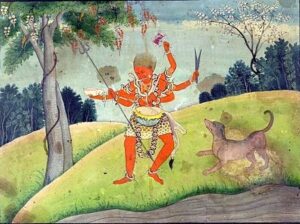 Kaal Bhairav is regarded as the guardian of Kashi since Lord Shiva is regarded as the ruler of Kashi and has charged him with keeping Kashi safe. Due to a dog’s unmatched qualities, such as alertness, olfactory ability, and devotion to its owner, Kaal Bhairav decided to make a dog his vahan. Additionally, he made a black dog his vehicle because it was challenging to spot it when acting as a watchdog, especially at night.
Kaal Bhairav is regarded as the guardian of Kashi since Lord Shiva is regarded as the ruler of Kashi and has charged him with keeping Kashi safe. Due to a dog’s unmatched qualities, such as alertness, olfactory ability, and devotion to its owner, Kaal Bhairav decided to make a dog his vahan. Additionally, he made a black dog his vehicle because it was challenging to spot it when acting as a watchdog, especially at night.
Lord Kartikeya’s Peacock (Paravani)
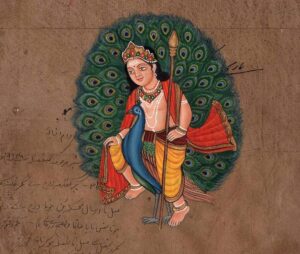 The oldest child of Lord Shiva and Mother Parvati, also known as Murugan and Nirguna in South India, is Lord Kartikeya. He is also known as the leader of the gods because he was cursed by his mother Parvati that he will always remain a child. Lord Vishnu gave Lord Kartikeya a chariot since he had been successful in taming his impulsive nature. As it is challenging to grow the peacock, the indication of Lord Vishnu giving more there denotes the triumph of humility and decency over arrogance and indecisiveness.
The oldest child of Lord Shiva and Mother Parvati, also known as Murugan and Nirguna in South India, is Lord Kartikeya. He is also known as the leader of the gods because he was cursed by his mother Parvati that he will always remain a child. Lord Vishnu gave Lord Kartikeya a chariot since he had been successful in taming his impulsive nature. As it is challenging to grow the peacock, the indication of Lord Vishnu giving more there denotes the triumph of humility and decency over arrogance and indecisiveness.
Lord Indra’s Elephant (Airawat)
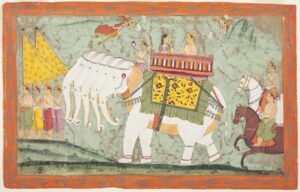 Lord Indra is regarded as the ruler of the gods. He is furthermore regarded as the deity of heaven. Hindu legend states that when all the gods and demons churned the ocean together, 14 diamonds emerged. A very strong white elephant with four fangs also appeared amid these stones, and Indra used it as his transport. By the way, elephants are revered in Hinduism not because they served as Indra’s vehicle but rather because Lord Ganesha has an elephant-like visage.
Lord Indra is regarded as the ruler of the gods. He is furthermore regarded as the deity of heaven. Hindu legend states that when all the gods and demons churned the ocean together, 14 diamonds emerged. A very strong white elephant with four fangs also appeared amid these stones, and Indra used it as his transport. By the way, elephants are revered in Hinduism not because they served as Indra’s vehicle but rather because Lord Ganesha has an elephant-like visage.
Lord Yamaraj’s Buffalo (Paundraka)
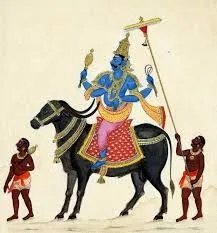 Yamraj is regarded as the deity of death. The Hindu faith has the view that after death, the righteous go to heaven and the wicked to hell. After monitoring an individual’s karma on earth, Yamraj chooses who will go to hell and who will go to heaven. A massive black buffalo serves as Yamraj’s (or Yama’s) vahana. In a similar vein, Yama Dev visits someone only when an individual’s death arrives. For this reason, he chose the buffalo as his mode of transportation.
Yamraj is regarded as the deity of death. The Hindu faith has the view that after death, the righteous go to heaven and the wicked to hell. After monitoring an individual’s karma on earth, Yamraj chooses who will go to hell and who will go to heaven. A massive black buffalo serves as Yamraj’s (or Yama’s) vahana. In a similar vein, Yama Dev visits someone only when an individual’s death arrives. For this reason, he chose the buffalo as his mode of transportation.
These are just a few gods and goddesses with animals as their vahanas. It proves how animals used to play an important role back then. They were worshipped and they must be worshipped even today! No matter how small or big an animal is.








